An excellent woodlander from Southeastern USA, but perfectly hardy in northern New England, is the Umbrella Leaf of Diphylleia cymosa, a member of the Berberidaceae. It's another of those classic examples of a small genus with one species found in Southeastern USA, and with one or two counterpart species found in Asia.
This plant has been very slow to establish, taking a decade to bulk up into a fine clump, probably because I have it in somewhat dry shade, when the plant prefers more moist conditions. But it never fails to provide a long season of foliar interest, if not amusingly so, as the leaves are indeed like crinkly brown umbrellas when they first emerge, the brown and green mottling lasting for weeks as the leaves expand. The single leaves are large, and reminiscent of Jeffersonia (Twin Leaf) with the mass of each leaf divided into two opposing sides, like big crazy neckties.
The cymes of white flowers are modestly attractive, the blue berries held on colored pedicels, appearing later in summer, are the attraction.
Since the plant can look quite different depending on stage of growth, I have uploaded a photographic sampling, + some interesting links:
distribution map and data sheet
http://plants.usda.gov/java/profile?symbol=DICY2
in Flora of North America (distribution maps on this resource are rather pathetic)
http://www.efloras.org/florataxon.aspx?flora_id=1&taxon_id=233500585
Some good photos at the North Carolina Native Plant Society site:
http://www.ncwildflower.org/index.php/plants/details/diphylleia-cymosa
Barry Glick and Sunshine Farm and Gardens site
http://www.sunfarm.com/picks/diphylleiacymosa-115422.phtml
Available at heronswood + good view of the berries:
http://www.heronswood.com/perennials_perennials-d-to-e_diphylleia/diphyl...
Comments
Re: Diphylleia cymosa - Umbrella Leaf
Nothing like visiting other gardens to learn from, and sometimes to learn why a plant one is growing is not doing so well. I had always wondered why Diphylleia cymosa was so slow growing, then discovered in the amazing naturalistic 6-acre garden (not all is cultivated) of George Newman in southern New Hampshire not far from me, that this dang thing is a swamp plant! Or at least a true moisture lover, growing with it's feet in spongy soil that is constantly moist, in George's garden, at the edge of a swampy location in fairly heavy shade.
There, it grew nearly as tall as humans, with much heavier clusters of berries (still green when I visited on June 12, 2010) triple the abundance than on my impoverished dry shade grown plants, the berry clusters at near eye level. The leaves seemed monstrously large to me, not quite 2' across, but getting close to that dimension. His plants had none of the red/brown mottling to the foliage, either a different clone, or with much more moisture and shade they green up.
Here's a few photos, on a rainy day, with mosquitoes the size of bats ;D In the second photo, George is leading the small pack of NARGS members (only 3 of us showed up that day for the garden tour).
Re: Diphylleia cymosa - Umbrella Leaf
Back in my dryland pseudo-woodland, under an ancient sugar maple, the foliage barely tops 24"-30" (60-75 cm), much smaller in size, distinctly and attractively mottled with brown. In the dryness, even with daily watering, the plant tends to retreat into early dormancy and shedding some leaves, or stems partly collapsing, although this does not seem to harm it in the long run. I think I like the plant better in the more austere conditions.
Although, the berries are MUCH FEWER under the drier circumstances. They are blue, with brilliant red pedicels. Squeezing the fleshy blue skin off reveals bright red seeds. I caught an interesting photo with a dragonfly slyly eying a hover fly.
Re: Diphylleia cymosa - Umbrella Leaf
Wow, what a spectacular sight at the garden you visited!
Actually, I wish mine looked like yours though, which are very beautiful, if not so gigantic... in our conditions, which I assume are even drier (and not helped by the overhanging chokecherry tree), mine is still only putting out 2 leaves and a single bloom, after several years... :(
Re: Diphylleia cymosa - Umbrella Leaf
Our NARGS New England Chapter held an seedling sale at the beautiful garden of Frank Simpson in southern New Hampshire. Frank's garden needs to be featured on this forum sometime; note to myself, photograph this extraordinary garden next spring 2011. But back to the point of this posting, Frank grows all three Diphylleia species. There is one American species, D. cymosa, and depending on references cited, there are either one or two additional specie, both Asian. They are D. grayi, and D. sinensis (syn. D. cymosa ssp. sinensis). They all look very similar. Luckily, D. grayi was in fruit, ready to pick, and Frank's allowed me to harvest some.
Re: Diphylleia cymosa - Umbrella Leaf
Came across Elizabeth Zander's Blogspot, which happened to feature Diphylleia cymosa, with two large size images showing just how attractive the leaves and "fruits" are, the light making the red pedicels glow, setting off the blue "berries". This is a good example on how much better the plants look, and how much more spectacular the fruits can be, when grown with sufficient moisture, as compared to my high and dry garden. Elizabeth brought parts of this plant in for a show & tell at a recent Berkshire Chapter NARGS meeting, and gave away fresh seed to anyone wanting some... there was considerable interest!
PS. It is nice being close enough to attend two different NARGS Chapter meetings as opportunities allow!
Elizabeth Zander Bogspot - Diphylleia cymosa
http://www.seed-aholic.com/2010/08/diphylleia-cymosa.html
http://4.bp.blogspot.com/_s6zXvYC7m2A/TFIlGVuqC0I/AAAAAAAAAZI/5DBcsnArbM...
http://4.bp.blogspot.com/_s6zXvYC7m2A/TFIlJX5aruI/AAAAAAAAAZQ/ptzq67SJiu...
Re: Diphylleia cymosa - Umbrella Leaf
Umbrella Leafs are plants for me. Slugs seem to dislike them at least as much as that the plants get a chance to grow to huge dimensions! I have two plants, I am not sure they are the same species or not. The American and Chinese species are very similar, as Mark tells. I think I bought two different species but I can't tell them apart.
Re: Diphylleia cymosa - Umbrella Leaf
Another plant to add to the wish list!
Re: Diphylleia cymosa - Umbrella Leaf
I planted this late last fall...a leftover orphan that had hung around the nursery too long & needed some TLC. It's in the streamside garden in mostly shade under large pines & spruces but will be in constant moisture. So after reading these posts I see it will most likely grow quite large, which is fine, although I really prefer the look of Mark's smaller & interestingly colored form. It will be fun in spring to see what this plant will turn out to look like. Spring is always like that!
Re: Diphylleia cymosa - Umbrella Leaf
Welcome to the Forum, Amy!
Wish I had a stream in my garden. I make due with a "dry stream." Well, it actually does drain excess surface water away from the house in the spring before ground thaw.
Re: Diphylleia cymosa - Umbrella Leaf
Nice work, Rick! Not much grass to mow there!
Amy, I am also lucky to have a small trickle in my garden, down in the wood, but slugs also like to forage there! I had problems with my first plants down there.
Re: Diphylleia cymosa - Umbrella Leaf
Sorry to take so long getting back here! Having a stream is the nicest feature of this small piece of heaven here in the foothills of the Green Mountains! I'm also on a small lake so the views are awesome. The stream really allows me to grow many of my favorite plants, the Primulas. But since I'm also in so much shade I have been working in many native woodlanders like the Diphylleia.
Re: Diphylleia cymosa - Umbrella Leaf
Love the George Newman garden!
Diphylleia (forget which, seeds from a European gardener) is another thing I have some seeds sown of that did nothing last year.. hoping for this spring....


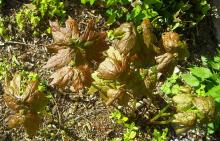
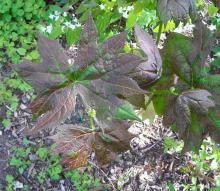

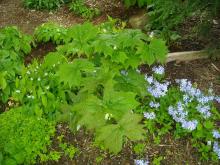
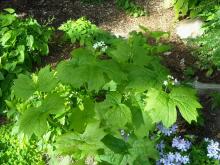
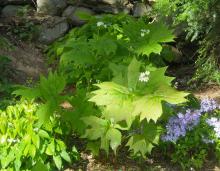
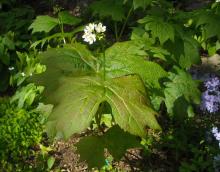

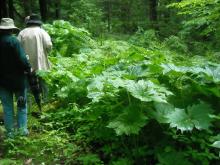
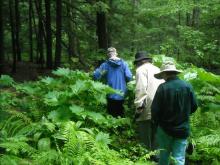
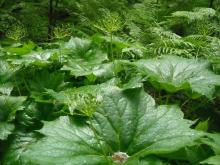
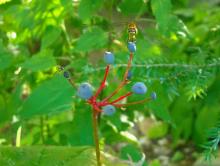

You're ahead of me, Mark! I think I have both species but neither had shown itself when I left for my cabin Wednesday (a long weekend!).